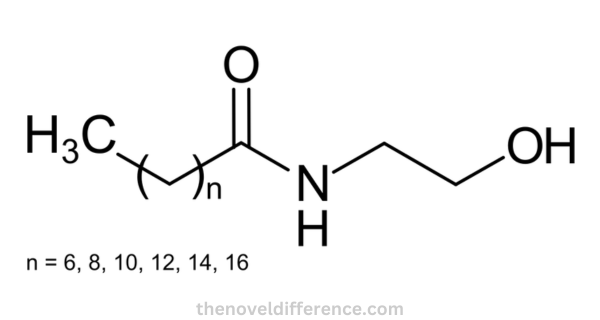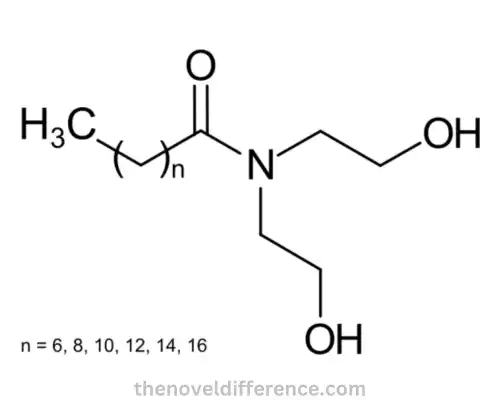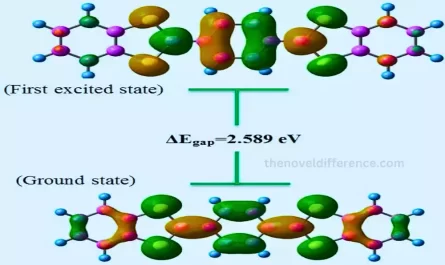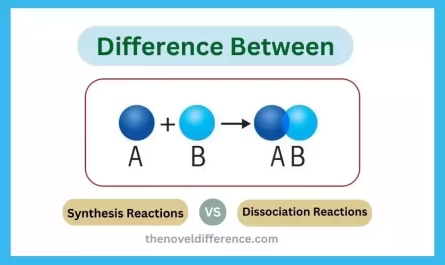Definition of Cocamide DEA and Cocamide MEA
Cocamide DEA and Cocamide MEA are two different types of cocamides, which are derived from coconut oil and are commonly used in the personal care and cosmetic industry.
- Cocamide DEA: Cocamide DEA, also known as Cocamide Diethanolamine, is a viscous liquid that is produced by reacting diethanolamine (DEA) with fatty acids derived from coconut oil. It is used primarily as a foam booster and surfactant in personal care products such as body washes and facial cleanser. Cocamide DEA helps to create rich lather and improve the cleansing properties of these products. It is also used to enhance the viscosity and stability of formulations.
- Cocamide MEA: Cocamide MEA, also known as Cocamide Monoethanolamine, is produced by reacting monoethanolamine (MEA) with coconut fatty acids. It is a waxy solid or a pale yellow liquid at room temperature, depending on the grade. Cocamide MEA is commonly used as an emulsifier, thickening agent, and conditioning agent in hair care products like conditioners, styling products, and hair dyes. It helps to improve the texture and consistency of formulations while providing moisturizing and conditioning properties to the hair.
Both Cocamide DEA and Cocamide MEA are derivatives of coconut oil and have similar functions in personal care products. However, they differ in terms of the specific amine compound used in their production, which affects their chemical structure and properties. It is important to understand these differences to make informed decisions regarding their usage, safety, and environmental impact.
Importance of understanding the difference between the two
Understanding the difference between Cocamide DEA versus Cocamide MEA can be important for a number of reasons.
- Product Formulation: Cocamide DEA & Cocamide MEA are different in their chemical structure and properties. This can have an impact on the functionality of these compounds when used to formulate products. Knowing their specific characteristics allows formulators to choose the most suitable ingredient for their desired product attributes. For example, Cocamide DEA’s surfactant and foam-boosting properties make it ideal for cleansing products, while Cocamide MEA’s emulsifying and conditioning properties make it suitable for hair care formulations.
- Functionality and Performance: Each cocamide offers unique benefits and performance attributes in personal care products. Understanding their differences helps in leveraging their specific functionalities effectively. By selecting the appropriate cocamide, formulators can optimize foam generation, stability, viscosity, conditioning effects, and other desired characteristics, ultimately enhancing the overall performance of the product.
- Safety Considerations: Cocamide DEA has been associated with potential safety concerns due to the potential formation of nitrosamines, which are classified as possible human carcinogens. Being aware of this controversy allows formulators, regulatory agencies, and consumers to make informed decisions regarding its usage and explore alternative options. On the other hand, Cocamide MEA is generally considered safe for use in personal care products, but it is still important to follow regulatory guidelines and restrictions.
- Regulatory Compliance: Different regions may have specific regulations and restrictions concerning the use of Cocamide DEA and Cocamide MEA in personal care products. Understanding these regulatory requirements ensures compliance and prevents potential legal issues or recalls.
- Consumer Awareness: Informed consumers are increasingly interested in understanding the ingredients used in the products they purchase. Being knowledgeable about the differences between Cocamide DEA and Cocamide MEA allows consumers to make educated choices based on their preferences, needs, and potential safety concerns.
- Environmental Impact: Assessing the environmental impact of ingredients is crucial for sustainable product development. Understanding the differences in the biodegradability and eco-friendliness of Cocamide DEA and Cocamide MEA helps formulators select ingredients that align with environmentally conscious practices and promote sustainable formulations.
Understanding the difference between Cocamide DEA and Cocamide MEA is essential for formulators, regulatory agencies, consumers, and the environment. It enables informed decision-making regarding product formulation, safety considerations, regulatory compliance, consumer choices, and sustainable practices.
What is the Cocamide DEA ?
Cocamide DEA, also known as Cocamide Diethanolamine, is an ingredient commonly used in the personal care and cosmetic industry. It is derived from coconut oil and is produced by reacting diethanolamine (DEA) with fatty acids obtained from coconut oil.

Cocamide DEA is primarily used as a surfactant and foam booster in various personal care products, including shampoos, body washes, facial cleansers, and bubble baths.
As a surfactant, it helps to reduce surface tension and allows water and oil to mix, enhancing the ability of cleansing products to remove dirt, oil, and impurities from the skin and hair. Additionally, Cocamide DEA contributes to the formation of rich lather and foam, improving the sensory experience during product use.
Furthermore, Cocamide DEA is known for its ability to enhance the viscosity and stability of formulations. It helps to thicken the consistency of products, providing a desirable texture and ensuring that they do not separate or become watery over time. This property is particularly useful in products such as gels, creams, and lotions.
It’s important to note that there has been some controversy surrounding the safety of Cocamide DEA due to the potential formation of nitrosamines, which are classified as possible human carcinogens.
Nitrosamines can form when Cocamide DEA reacts with other ingredients or is contaminated with certain substances. As a result, some regulatory bodies have imposed limitations and guidelines on the use of Cocamide DEA in certain regions.
Overall, Cocamide DEA is a versatile ingredient that contributes to the cleansing, foam-boosting, thickening, and stabilizing properties of various personal care products. However, due to safety concerns, it is crucial to follow regulatory guidelines and explore alternative options for formulating products when necessary.
What is the Cocamide MEA ?
Cocamide MEA, also known as Cocamide Monoethanolamine, is an ingredient commonly used in the personal care and cosmetic industry. Like Cocamide DEA, Cocamide MEA is derived from coconut oil.

Cocamide MEA is produced by reacting monoethanolamine (MEA) with fatty acids obtained from coconut oil. It is primarily used as an emulsifier, thickening agent, and conditioning agent in hair care products, including conditioners, styling products, and hair dyes.
As an emulsifier, Cocamide MEA helps to stabilize oil and water mixtures in formulations. It allows for the even distribution and blending of ingredients that would otherwise separate. This property is particularly useful in hair care products that contain both water-based and oil-based components.
Cocamide MEA also acts as a thickening agent, contributing to the viscosity and consistency of formulations. It helps to give products a desirable texture, making them easier to apply and ensuring they stay in place without being too runny or watery.
In addition to its emulsifying and thickening properties, Cocamide MEA provides conditioning benefits to the hair. It helps to moisturize and soften the hair strands, improving their manageability, reducing frizz, and enhancing the overall appearance and feel of the hair.
It is important to note that Cocamide MEA is generally considered safe for use in personal care products. However, it is still important to follow regulatory guidelines and restrictions that may vary in different regions.
Overall, Cocamide MEA is a versatile ingredient that contributes to the emulsifying, thickening, and conditioning properties of hair care products. It helps to improve the performance and sensory attributes of formulations, resulting in enhanced hair care experiences for consumers.
What are the Difference Between Cocamide DEA and Cocamide MEA ?
You can summarize the main differences between Cocamide DEA vs Cocamide MEA as follows:
- Chemical Structure: Cocamide DEA can be produced by reacting diethanolamine with fatty acid derived from coconut oils, while Cocamide MEA can be produced by reacting monethanolamine with coconut fatty acid. The different amines used in their production give them distinct chemical structures and properties.
- Functionality: Cocamide DEA is primarily used as a surfactant and foam booster in personal care products. It helps to reduce surface tension, allowing water and oil to mix, and contributes to the formation of lather and foam. On the other hand, Cocamide MEA is mainly utilized as an emulsifier, thickening agent, and conditioning agent in hair care products. It stabilizes oil and water mixtures, enhances product viscosity, and provides moisturizing and conditioning benefits to the hair.
- Applications: Cocamide DEA is commonly found in cleansing products such as shampoos, body washes, and facial cleansers, where its surfactant properties are beneficial. Cocamide MEA, however, is most frequently found in hair care products such as conditioners and styling aids that contain conditioners to add shine. With its thickening properties and ability to emulsify, thicken and condition hair effectively – Cocamide MEA makes a powerful combination.
- Safety Concerns: Cocamide DEA has been associated with potential safety concerns due to the potential formation of nitrosamines, which are classified as possible human carcinogens. Regulations and restrictions on the use of Cocamide DEA exist in some regions to mitigate these concerns. Cocamide MEA, on the other hand, is generally considered safe for use in personal care products, but compliance with regulatory guidelines is still important.
- Environmental Impact: Assessing the environmental impact of ingredients is important for sustainable product development. Cocamide DEA has been associated with potential ecological consequences, and its biodegradability and persistence in the environment have been a subject of concern. In contrast, Cocamide MEA is generally considered to have better biodegradability and eco-friendly properties.
Understanding these differences allows formulators, regulatory agencies, and consumers to make informed decisions regarding the selection, usage, safety considerations, and environmental impact of Cocamide DEA and Cocamide MEA in personal care products.
Chemical Composition and Structure
Cocamide DEA and Cocamide MEA have different chemical compositions and structures due to the different amines used in their production.
Here are the details of their chemical composition and structure:
- Cocamide DEA:
-
- Chemical Name: Cocamide Diethanolamine
- Chemical Formula: C21H45NO3
- Structure: Cocamide DEA is produced by reacting diethanolamine (DEA) with fatty acids derived from coconut oil. It forms an amide bond between the DEA molecule and the fatty acid, resulting in a diethanolamide structure. The hydroxyl groups of the DEA molecule contribute to its surfactant properties.
- Cocamide MEA:
-
- Chemical Name: Cocamide Monoethanolamine
- Chemical Formula: C19H41NO3
- Structure: Cocamide MEA is produced by reacting monoethanolamine (MEA) with coconut fatty acids. Similar to Cocamide DEA, it forms an amide bond between the MEA molecule and the fatty acid. However, in Cocamide MEA, only one hydroxyl group of the MEA molecule is involved, resulting in a monoethanolamide structure. This structure contributes to its emulsifying, thickening, and conditioning properties.
Cocamide DEA and Cocamide MEA have similar origins as derivatives of coconut oil. However, their chemical compositions and structures differ due to the specific amines used in their production, resulting in variations in their functional properties and applications in personal care products.
Safety Considerations
Safety considerations play an important role in the use of Cocamide DEA and Cocamide MEA in personal care products.
Here are the key points to consider regarding their safety:
- Cocamide DEA Safety:
-
- Controversy: Cocamide DEA has been associated with potential safety concerns due to the potential formation of nitrosamines. Nitrosamines are classified as possible human carcinogens and can form when Cocamide DEA reacts with other ingredients or is contaminated with certain substances.
- Regulatory Guidelines: Several regulatory bodies, such as the European Union and California’s Proposition 65, have set limitations and guidelines on the use of Cocamide DEA in cosmetic and personal care products to address the potential nitrosamine formation. Compliance with these guidelines is important to ensure the safety of consumers.
- Safety Assessments: Various safety assessments and studies have been conducted to evaluate the potential risks of Cocamide DEA. These studies consider exposure levels, nitrosamine formation potential, and other safety aspects. It is important to review and consider the findings of these studies when formulating products.
- Cocamide MEA Safety:
-
- Generally Considered Safe: Cocamide MEA is generally considered safe for use in cosmetic and personal care products. It has a long history of use without significant safety concerns.
- Regulatory Compliance: While Cocamide MEA is considered safe, it is still important to follow regulatory guidelines and restrictions that may exist in different regions. Compliance with these regulations ensures the appropriate usage and concentration of Cocamide MEA in formulations.
- Safety Data: Safety data, including toxicological studies and assessments, support the safe use of Cocamide MEA in cosmetic and personal care products. Manufacturers and formulators should refer to reliable safety data and comply with regulatory requirements.
It is crucial for formulators, regulatory agencies, and consumers to stay updated with the latest scientific research and regulatory guidelines regarding the safety of Cocamide DEA and Cocamide MEA. Responsible usage, compliance with regulations, and periodic safety assessments are important considerations to ensure the safety of products containing these ingredients.
Environmental Impact
The environmental impact of Cocamide DEA and Cocamide MEA is an important consideration in the formulation and use of personal care products.
Here are the key points to understand regarding their environmental impact:
- Cocamide DEA:
-
- Biodegradability: Cocamide DEA has been found to have varying degrees of biodegradability depending on the specific formulation and conditions. Some studies have shown that it can degrade under aerobic conditions, but the rate of degradation may be slower compared to other surfactants.
- Ecotoxicity: Cocamide DEA has been associated with potential ecotoxicological effects on aquatic organisms. It is important to ensure that products containing Cocamide DEA are properly treated and disposed of to minimize environmental impacts.
- Cocamide MEA:
-
- Biodegradability: Cocamide MEA is generally considered to have better biodegradability compared to Cocamide DEA. It can be broken down by natural processes, reducing its persistence in the environment.
- Environmental Fate: Studies have indicated that Cocamide MEA can undergo biodegradation under aerobic conditions, which is favorable for its environmental fate.
When formulating products, it is important to consider the overall environmental impact of ingredients like Cocamide DEA and Cocamide MEA. Here are some general strategies to minimize environmental impact:
- Use Environmentally Friendly Alternatives: Consider using alternative ingredients that have a lower environmental impact and possess similar functional properties.
- Formulation Optimization: Optimize formulations to minimize the use of cocamides and other potentially harmful ingredients, reducing the overall environmental load.
- Waste Management: Implement proper waste management practices to ensure that products containing cocamides are disposed of responsibly and do not end up contaminating water bodies or soil.
- Life Cycle Assessment: Conduct a life cycle assessment to evaluate the environmental impact of the entire product, from raw material sourcing to manufacturing, usage, and disposal.
By adopting sustainable practices and considering the environmental impact of ingredients like Cocamide DEA and Cocamide MEA, it is possible to reduce the ecological footprint associated with personal care products.
Conclusion
Understanding the differences between Cocamide DEA and Cocamide MEA is crucial for formulators, regulatory agencies, and consumers in the personal care industry.
Cocamide DEA is commonly used as a surfactant and foam booster, while Cocamide MEA serves as an emulsifier, thickening agent, and conditioning agent in hair care products. The specific functionalities of these ingredients impact their suitability for different formulations and desired product attributes.
Safety considerations are important when using Cocamide DEA and Cocamide MEA. Cocamide DEA has been associated with potential safety concerns due to the formation of nitrosamines, which are classified as possible human carcinogens.
Regulatory guidelines exist to mitigate these concerns. Cocamide MEA, on the other hand, is generally considered safe for use but compliance with regulatory requirements is still necessary.



